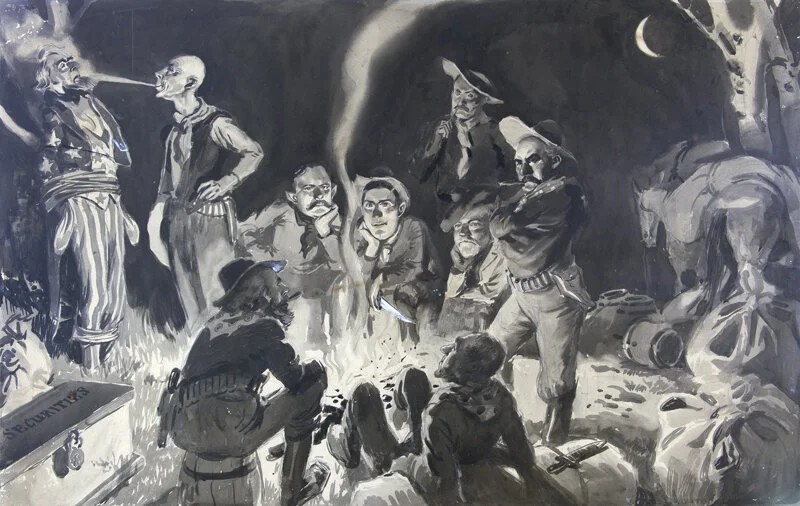
James Montgomery Flagg Robber Barons

James Montgomery Flagg had a legendary career as an artist, illustrator and cartoonist. His work ranges from the satirical political cartoon all the way to fine art portraiture. His works of both illustration and political cartoons were published in multiple magazines such as Leslie’s Weekly, Judge, Life and Puck- all of which had national recognition in the late 19th and early 20th century. He was invited into the homes and lives of some of the greatest figures of his time; drawing beautiful portraits of Hollywood Royalty such as the Barrymores and using his abilities to speak out against social injustices.
In the manner of most of his famous works, this illustration contains a very political message. Recognizing the “cowboys” that are depicted, it is clearly from the early 1900’s. All of these men were considered “Titans” of that time. From John D. Rockefeller blowing smoke in Uncle Sam’s face to Theodore Roosevelt sitting in stern concentration, this was a reference to a political scandal involving big business, the president, and the American people. Uncle Sam, historically, has come to be viewed as the personification of the American people and culture as a whole. Flagg has shown him as a hostage of the big business tycoons of the early 20th century. It is likely that this illustration is denouncing the Coal Strike of 1902; a sordid affair in which it was alleged that Theodore Roosevelt took campaign funds from business owning donors in order to favorably handle the mine workers union and their request for higher wages and fair work hours. President Roosevelt had wanted to intervene but was told he had no authority to do so by his Attorney General. Roosevelt’s supporters, those that had felt they had put him in office specifically to intervene and serve their interests, were vocal about wanting his help to fix the strike to benefit the coal mine owners. They were also not afraid to remind Roosevelt publicly that he was in his position due to their favor. (https://en.wikipedia.org/wiki/Coal_strike_of_1902)
Some of the biggest players against the coal miners union and their requests are depicted in this illustration as cowboys on the trail. From left to right in the background: (standing) Uncle Sam,(standing) John D. Rockefeller, (seated) Theodore Roosevelt, (seated)William Gibbs McAdoo, (seated) Andrew Carnegie, (standing)John J. Astor IV, (standing) Nelson Wilmarth Aldrich. In the foreground, left to right: (seated on barrel) Henry Frick and (leaning back) Cornelius Vanderbuilt.
James Montgomery Flagg sold his first illustration at the age of twelve and was a regular illustrator for Life magazine by the age of fourteen. At the height of his career he was considered the highest paid illustrator in American history. He was a star illustrator and artist of his time, and stretching into the present day. Flagg had a long and successful career spanning nearly 60 years and in that time he was always a recognized and lauded figure in the art community. Through his work he was able to create a portfolio full of portraits, illustrations, published books and more.
(https://illustrationchronicles.com/I-Want-YOU-The-Story-of-James-Montgomery-Flagg-s-Iconic-Poster)
Flagg is most notably considered the “father” of our modern day depiction of Uncle Sam; creating the iconic wartime posters stating: “I WANT YOU FOR THE US ARMY” While this character of Uncle Sam, as created by James Montgomery Flagg, isn’t credited with his unveiling on the cover of Leslie’s Weekly until 1916, he was a part of Flagg’s political satire as early as 1901. Uncle Sam, as depicted by Flagg, was actually a self-portrait of sorts. The familiar figure seen on the WWI and WWII posters was Flagg himself as the model. In fact, he was photographed in his Uncle Sam garb by several of his friends and patrons and it is clear that he was the man in the hat.
James Montgomery Flagg was an important figure in 20th Century American illustration, art and political cartoons. He was clearly an artist with a very patriotic heart and he used his body of work to encourage and give voice to the American people. This “Untitled” illustration is no exception to that rule.
